Belur is a small town in the Hassan district of Karnataka, situated on the banks of the Yagachi River, amidst lush surroundings. Also known as Velapura, it is an ancient and important town. The capital city of the Hoysalas, the rulers of the 10th-14th century Karnataka. They are known for their beautiful temple architecture, for example, the Chennakesava Temple, and were great patronage of art, literature, and religion.
The Hoysalas of Belur

The Hoysalas were primarily from a region called Malenadu in the Western Ghats, known for being well-versed in warfare techniques. They took advantage of the internal ongoing wars between the Chalukyas and the Kalachuri dynasty and annexed the areas under present-day Karnataka. By the 13th century, they were ruling most parts of Karnataka, minor parts of Tamil Nadu, and some parts of western Andhra Pradesh and Telangana.
Hoysala Architecture
The Hoysala period is considered a golden period of the region for its influence on art, architecture, literature, and religion and in the development of South India. They ruled from the city of Belur as their capital but later moved to Halebidu, also known as Dwarasamudra. They are remembered today primarily for the brilliant Hoysala Architecture.

There are about 92 temples present today, out of which about 35 are in the Hassan district. Prominent among them are Chennakesava Temple in Belur, Hoysaleshwar Temple in Halebidu, and Chennakesava Temple in Somnathpura. Other temples like Laxmi Narasimha in Nuggehalli, Veer Narayan in Belawadi, Ishwar Temple in Arasikere, Bucheswara in Koravangla, Jain Basadi in Halebidu, Brahmeshwara in Kikkeri are also a distinct example of Hoysala architecture.
Etymology of Hoysala
According to Kannada folklore, there was a young man called Sala who saved his Guru from a tiger by striking him with a sword. Since “strike” in old Kannada was called “Hoy”, hence, the name Hoysala.
Chennakesava Temple Complex, Belur
Chennakesava temple is one of the finest examples of Hoysala architecture. The temple is locally referred to as Kalasagar for its breathtaking carvings and fine sculptures. The beauty is so expressive that one can feel life inside these non-living stone structures.
History of Chennakesava Temple
The temple in Belur was built by Vishnuvardhan in 1117 AD. It took 103 years for the three generations of the royal family to complete this architectural masterpiece. It is said that over 1000 artists were involved in creating this wonder on stone.
The temple is dedicated to Lord Vishnu known as Chennakesava, which means beautiful (chenna) Vishnu (Keshava).
The temple was built to commemorate an important military victory by King Vishnuvardhan over the Cholas. According to another local belief, it was built in honor of Lord Vishnu to mark the conversion of King Vishnuvardhan from Jainism to Vaishnavism. King Vishnuvardhan was called Bittidev when he was a practicing Jain but under the influence of his Guru, Shri Ramanujacharya, he converted to Hinduism. His queen Shantala Devi was a great patron of arts, music, and dance. She herself was a versatile Bharatnatyam dancer and was also known as Natyasamragyi or the queen of dance.
Gopuram of Chennakesava Temple
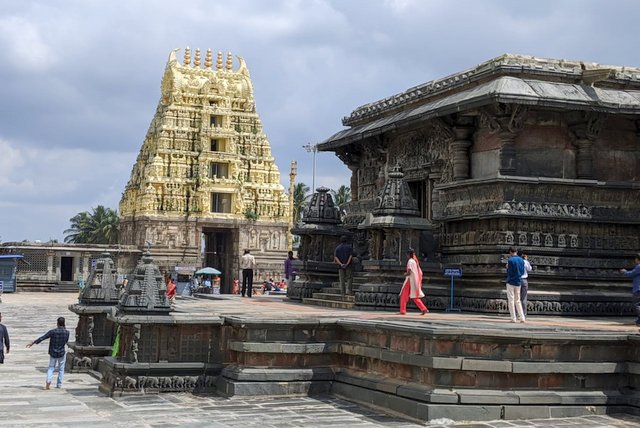
The huge temple is enclosed in a walled structure. There are two entrances to the temple. The one from the east has a huge five-storeyed Gopuram. The main entrance was destroyed by the invaders from Delhi Sultanate which was later restored during the Vijayanagar Empire.
The bottom part of the Gopuram is made of hard stone while the top is made of brick and mortar. It is richly decorated with figures of Gods and Goddesses. There are two structures on the topmost corners in the shape of cow’s horns, hence the name Go-Puram, and between the two horns are five golden Kalashas or pots.
Main Temple
The main temple is a unique star-shaped structure set on a raised platform called Jagati. The temple consists of a Garbhagriha (inner sanctum), Sukanasi (vestibule) and a Navranga mandapa. There used to be a vimana or shikhara made of brick and mortar supported by woodwork that was plated with gold-gilded copper sheets. It had to be dismantled during the early 19th century in order to save the inner sanctum.

There are three gateways to the temple in the east, north, and south direction through which one can enter the Navranga mandapa. The temple is built with soapstone and is full of intricate designs throughout its structure.

The entrance on the east is decorated with Makara Torana. The overhead panel on the main door depicts the ten avatars or forms of Lord Vishnu. On both sides of the gate are two huge structures of Sala killing the tiger, the state emblem of the Hoysalas. There are two small shrines on each side of the emblem dedicated to Lord Vishnu. On the walls on each side of the east gate are carvings of court scenes of King Vishnuvardhan on the left and his grandson Veer Ballala, on the right.

The temple doors are also carved with outstandingly beautiful filigree work. In front of the east gate towards the Gopuram is a golden Dhwajastambha. In front of it is a beautifully carved structure of Garuda, the vehicle or Vahana of Vishnu, facing towards the shrine.
Navrang Mandapa

The large Navrang Mandapa is adorned with highly polished and richly sculpted 48 pillars and ceilings. The pillars are of different designs and styles. Out of these pillars, the four pillars at the center are the most important.
Most remarkable among them is the Mohini pillar on the southwest and the Narsimha pillar on the southeast. Mohini pillar is sixteen fluted star-shaped pillars with a large figure of Lord Vishnu in the form of Mohini. The Narsimha pillar is richly carved with minute reliefs and structure. The pillar is said to be once rotating on its own axis with the help of stone ball bearing but it stopped after the vimana or shikhara was dismantled.

The four central pillars are crowned by four bracketed figures at the top corner. These figures are the finest specimen of Hoysala craftsmanship. These figures depict:

- Shuka Bhashini – a lady in conversation with her pet parrot
- Queen Shantaladev
- Gandharva dance
- Kesh Shringara – a lady wringing her hair after the bath
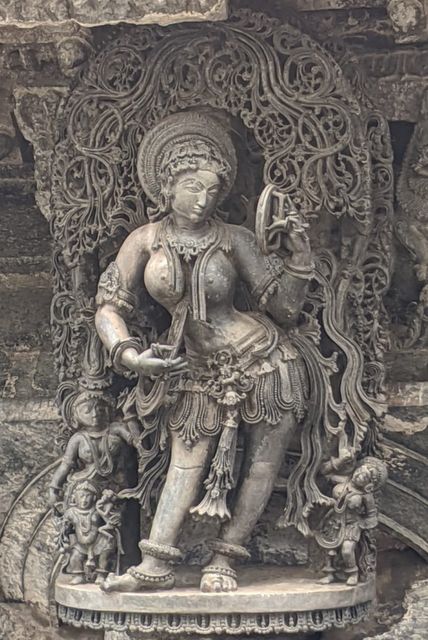
The figures of the Gandharva dancer and Shantaladevi are noteworthy as their accessories are movable. It is said that the tiny ring on the headdress of the Queen, on the southwest pillar and the bracelet on the arm of the dancer, on the northwest pillar can be rotated.
Ceiling
The central ceiling of the mandapa is an exceptional beauty carved on stone. The ceiling is in the shape of an inverted lotus between two concentric circles. The central part of the circle is in the shape of an inverted Linga, with Narasimha carved on the base, and a lotus flower in the middle symbolic of Brahma. The Trinities are represented in a single stone through symbols, also called Trimurti Sangama Bhubaneshwari.
Most of the Hoysala temples in and around Belur are dedicated to the Narasimha form of Lord Vishnu as He is considered their family God. The façade of the mandap has a perforated screen with square and diamond-shaped holes for the passage of air and light. This is a signature element of Chalukyan or Hoysala Architecture.
GarbhaGriha

The mandapa on the west side leads to the Garbhagriha or the inner sanctum. It enshrines the beautifully ornamented 6ft high idol of Lord Vishnu in his Chaturbhuj or four-armed mudra with a halo, standing on a 3 ft pedestal. The upper two hands hold the discus and the conch whereas the lower two hands hold the mace and the lotus. The halo has cyclical carvings of the ten avatars or forms of Lord Vishnu.

It is flanked by idols of his consorts- Sridevi and Bhudevi. The gateway of the inner sanctum is decorated with Makara Torana and filigree works. There is a figure of Lord Vishnu and Devi Lakshmi on the top of the gateway. On both sides of the door are the two Dwarapalas – Jay and Vijay, richly carved and decorated.
An inscription in old Kannada near the northern entrance of Navaranga mandap of the temple states that the deity was also called Vijaynarayana.
The exterior walls of Chennakesava Temple
The exterior walls of the main temple are opulently carved with figures of animals, humans, Gods, and Goddesses.
The wall of the Navrang mandapa depicts the social fabric – the Jivatma whereas the walls of the Garbhagriha depict the spiritual life and tales from the Puranas – the Paramatma.
Every inch and corner of the outer wall of the temple is intricately carved and beautifully decorated. The bottom of the wall has horizontal rows of carvings of elephants, lions and small figurines richly ornamented and intersected by larger vertical images. These images were carved out of a single stone with a stone interlocking system, locked with the wall. Similar stone interlocking can be seen on the hanging eaves of the roof around the temple wall.
Elephant Carvings
There are about 650 carvings of elephants in different moods and no two figures are alike. There are 38 bracketed figures angled between the outer wall and the overhanging eaves around the walls of the Navaranga mandapa and the Garbhagriha. These bracketed figures are filigreed and adorned with beauties called Madanikas in various dancing poses and other rituals like:
- A lady admiring herself in the mirror
- A monkey pulling the saree of a lady
- Lady dressing her hair after the bath
- Lady aiming an arrow
- A lady in Tribhangi Mudra with her body bent in three places
- Lady playing Rudra Veena
- Lady looking at a lizard who is eyeing a fly sitting on jackfruit

Many such ethereal beauties are carved on stone. The mythological aspects are beautifully depicted on the walls of the Garbhagriha like:
- Narasimha killing Hiranyakashyipu
- Mahisasurmardini
- Ravana lifting Kailasha mountain
- The Sun God
- Shiva killing Andhakasur
- Tales from Ramayana and Mahabharata.

There is a large footprint on the platform towards the north side. The footprints are believed as those of Lord Vishnu. If you do not have a darshan of the deity inside, you can worship the footprints outside.
Inscriptions
On the east wall of the north gate of the temple are inscriptions in old Kannada about the detailed structure, history, and donations for the temple. There are small shrines of Lord Vishnu on both sides of the entrances on the north and south gate towards the Navaranga mandapa.
Apart from the main temple, the complex has many other beautiful temples and shrines. There are Kappe Chennigaraya Temple, Veernarayana Temple, Saumyanaki Temple, Andal Temple, Kalyana Mantapa or the wedding hall, Deepastambha, a kitchen, a water tank, and structures.
Other Temples and Elements
Deepastambha

Inside the temple complex on the left side of the gopuram towards the south is a huge 42 feet high pillar carved out of a single stone called Deepastambha.
It is also called an antigravity pillar. It is standing on its own weight on a raised platform without any support. The base of the pillar towards the north is little raised resulting in a gap between the platform and the pillar. A piece of paper can easily pass through the gap. An outstanding example of skilled and amazing craftsmanship.
As per our local guide, there used to be a staircase around the pillar, used as support for lighting the deepam or the lamps. Now people are not allowed to climb on the platform or to go near the pillar.
Kappe Chennigaraya Temple
This temple in the south is considered the blueprint of the main temple. It was built by Shantala Devi, the queen of King Vishnuvardhan. There is an impressive Murti of Lord Vishnu as Chennigaraya. It was installed at the same time as the Keshava idol in the main shrine. The temple has two sanctums – one for Kappe Chennigaraya and the other for Venugopal. There are sculptures of other deities like Ganesha, Saraswati, Durga, and Lakshmi Narayana.
The Murti in the sanctum has a legend associated with it. It is said that a famous sculptor called Jakanachari from Kaidala or Kridapura village was given the responsibility of sculpting the shrine of this temple. His son named Dankanachari came to Belur searching for his father as he had not seen him for years.
Sculpting the main deity
He saw his father sculpting the main deity and told him that the stone on which he was sculpting was defective. His father was furious at the audacity of the stranger, unaware of his identity. He vowed that he would cut his hand if the stone has any defect. Dankanchari smeared sandalwood paste on the entire surface of the stone and left it to dry. The next day, it was observed that a small patch near the navel of the idol was wet and when it was tapped with a chisel, water appeared from it along with a frog (Kappe in Kannada).
The son revealed his true identity but failed to dissuade his father from cutting his hands. The main sculptor cut his hand honoring his words. It is believed that since then the main deity in the shrine is called Kappe Chennigaraya. The story further mentions that Lord Vishnu directed Jakanachari to build another shrine dedicated to Him in his native village. When he followed the divine instruction, his hand was finally restored and since then the village comes to be known as Kaidala (restored hand). This temple still exists in Kaidala village in Tumkur district.
Veera Narayana Temple
This is a small but beautiful temple located towards the west and is dedicated to Veera Narayana or Lakshmi Narayana. The outer walls of this temple are adorned with beautiful structures of Brahma, Shiva, Parvati, Saraswati, Bhairava, and Mahisasurmardini. The temple is constructed on an elevated platform like most of the contemporary Hoysala temples. It consists of a Garbhagriha, Sukanasi, and a Navrang mandapa.
Saumyanaki Temple
This is an important temple dedicated to Goddess Sridevi towards the southwest of Keshava Temple. It has a Garbhagriha, Sukanasi and a Mandapa. The temple is adorned with a vimana or shikhara which is said to resemble the original vimana of the Keshava temple that has been brought down. The outer wall is adorned with sculptures.
Ranganayaki Temple (Andal Shrine)

Located to the northwest of Keshava Temple, Andal Shrine is dedicated to the poet-saint believed to be an incarnation of Mahalakshmi. She is the only female among the 12 Vaishanavite Alvar saints of South India. The temple wall is adorned with images of various deities having a canopy. The main deities include Lakshmi, Mohini, Venugopal, and Lakshminarayana. The temple consists of Garbhagriha, Sukanasi, and the Mandapa. There is a vimana or Shikara with a golden Kalasha.
Other smaller shrines inside the complex are dedicated to Ramanujacharya, Krishna, Narasimha, Anjaneya, and Ramachandra. Near the Veernarayana temple is the Vahana Mantapa where the procession vehicles like the Ratha or temple car used to be traditionally stored. The complex also has a Kalyana mandapa or wedding hall towards the southeast corner for conducting ceremonies. A granary for storing food grains and a community kitchen or Paakashale are located towards the northwest corner of the complex.
Vasudev Sarovar
There is a small stepped water tank or Kalyani found on the northeast corner, on the right of the gopuram. It is also called Vasudev Sarovar as per the inscription near the water tank. On the side of the tank, there are two carved stone elephants. There are two small shrines situated on the side of the tank. The entrance to the tank was closed.
Temple Festivals at Belur
Annual Rathotsava is the major festival celebrated in Belur in the month of March-April, 12 days after Ugadi or Kannadiga New Year. The festival is celebrated for two days when the Utsava Murti is drawn on a huge wooden chariot. Covering the eastern part of the temple on the first day. And other parts of the temple are covered on the second day. A fair or Jaatre is held during the annual festival that lasts for ten days.
Travel Tips

- Belur is about 200 km from Bangalore. A day road trip is possible. However, the nearest town is Hassan which is an hour’s drive.
- It is advisable to stay in Hassan so that both Belur and Halebidu, another Hoysala marvel can be explored on the same day.
- Hassan is well connected by road and rail with important towns and cities of Karnataka. KSRTC buses regularly ply from important towns and cities.
- Good hotels are available in Hassan, hence staying would not be a problem.
- The best time to visit Belur is between October to March.
- Early morning and late afternoon should be the preferred time for a visit.
- Decent restaurants are available near the temple for snacks and lunch.
- Beautiful stone artifacts are available near the temple which can be bought as a souvenir.
- It is advisable to hire a guide. Guide charges are fixed by the association @Rs 300/-.
This is a post by Shruti Mishra under Inditales Internship Program.



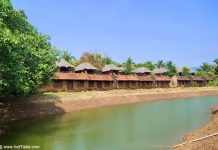

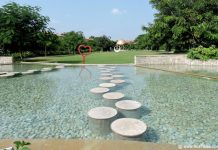


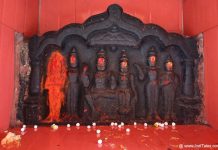






We have such a beautiful and great patronage of art, literature, and religion in our nation. We have many such sites and places of our own heritage which are all for one or other reason, much better then the previous one. Particularly South India or the part of our great nation below Narmada river have better heritage of our own. Why such places are still gone unnoticed? Is it only because of extra publicity of Taj-Mahal? It is high time that we must come out of the shadow of Taj and give much needed publicity to make such places more popular…
Truly said. Our country has a rich heritage wherever you visit. We need to expand our horizon
Very well researched and things are articulated perfectly. Fusion of history and mythology keeps your interest going till you scroll down to the end. Meticulously mentioned the travel tips for those who are going for the first time.
Thank you for liking the post. This temple is a must visit for art lovers.
Madam,
Do visit Lakshmi Devi Temple, Doddagaddavalli and Veera Narayana Temple, Belavadi these two are very beautiful temples situated among small village and best thing you want have tourist unlike Belur and Halebidu.
I have visited these places. They too are wonders on stones.
We have many such sites and places of our own heritage which are all for one or other reasons, much better than the previous one.
True. We must try to preserve our rich culture and tradition
Nice Carving, Nice Temple,
Nice Blog
Thank you
Feeling Proud and appreciate for reminding of Belur – Chennakesava Temple, Karnataka.
Also, there is a need to take measures to protect our heritage.
Absolutely true. Each temple is unique in its own way
I loved it. I had already visited several of these references before and they really have very good articles to offer. Congratulations excellent for travel lovers.
Thanks for liking. This temple is truly a wonder on stone
Amazing Article is really happy to say it was an interesting post. Information Is Awesome. Thanks For Sheering.
Thank you
Great article… I loved it
Thank you.
The Hoysalas of Belur is very Good Place
nice
Thanks for sharing about this wonderful temple. This are an ancient site and a very good example of Hoysala craftsmanship. The Temple is very unique in its own way and you are doing very well researched and the fusion of history and mythology keeps your blogs for interesting.
Great article and nice post.
first of all Thank you for sharing this article. Its so amazing that india has such amazing and Fascinating temples almost in every states.
I simply wish to give an enormous thumbs up for the nice information you will have right here on this post.
I might be coming again to your blog for more soon.
Great article and nice post.
interesting information…
I would like to thank you for your good content.
There is another fine Hoysala temple on the way to Belur from Hassan. It is the Lakshmidevi Temple at Doddagadduvalli
Yes, please read about that in our post on Hoysala Temples.